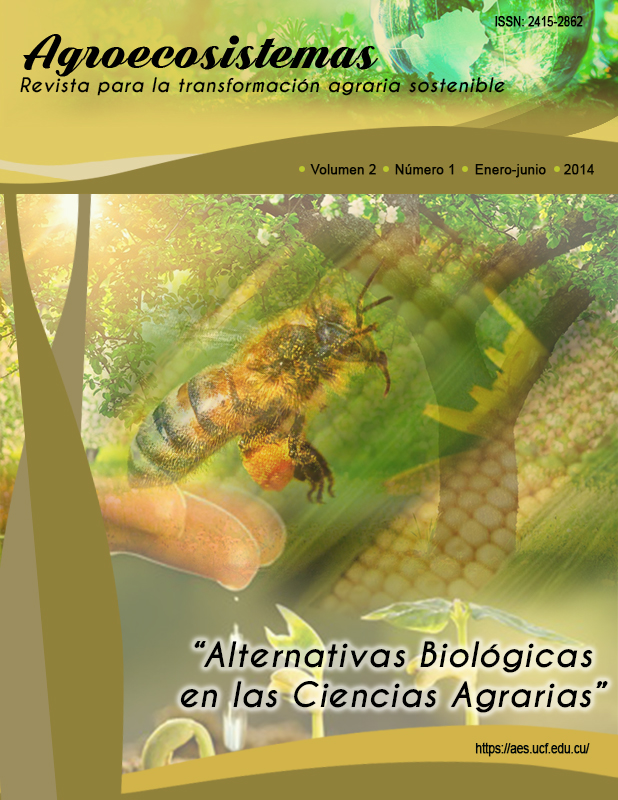Incidencia de <em>Phytophthora nicotianae</em> Breda de Haan en el cultivo del tabaco, durante cinco campañas en el municipio de Cabaiguán
Resumen
El objetivo del presente trabajo fue evaluar la incidencia de Phytophthora nicotianae Breda de Haan (pata prieta) en el cultivo del tabaco (Nicotiana tabacum L.), durante cinco campañas en el municipio de Cabaiguán en relación a las fechas de plantación, las variedades presentes y las condiciones meteorológicas. La investigación fue realizada en el territorio de la Estación de Protección de Plantas de Cabaiguán, ubicada a 2,5 km de la cabecera municipal, provincia de Sancti Spiritus. Se efectuó la investigación durante las últimas cinco campañas tabacaleras 2004-2005 a 2008-2009. Para ello se realizó una revisión documental de la información recogida en la Estación de Protección de Plantas de Cabaiguan sobre la pata prieta del tabaco relacionada con, fecha de primera aparición por campaña, niveles de incidencia por campaña, por fecha de plantación y por variedades, así como las condiciones meteorológicas concurrentes. La pata prieta incidió en el tabaco en las cinco campañas estudiadas, su primera ocurrencia por campaña se presenta desde la tercera decena de octubre hasta la primera de diciembre. Los mayores niveles de áreas de tabaco afectadas y perdidas, se presentaron en la campaña 2006-2007 asociados con un periodo más lluvioso con temperaturas y humedades relativas más altas. La dinámica de la enfermedad puso en evidencia que esta comienza con afectaciones ligeras y se va incrementando con las mayores afectaciones desde la segunda decena de enero hasta la primera de marzo. Todas las variedades son afectadas por la enfermedad con una incidencia relativa menor en H-2000 y mayor SS-96.
Palabras clave: Nicotiana tabacum, enfermedades, pata prieta.
Abstract
The objective of the present work was to evaluate the incidence of Phytophthora nicotianae Breda de Haan (black foot) in tobacco (Nicotiana tabacum L.), during five crop seasons in the Cabaiguán municipality in relation to the plantation dates, the varieties presents and the meteorological conditions. The investigation was carried out on tobacco black foot in the territory of the Protection Plants Station of Cabaiguán, Sancti Spiritus province. A study was made during five tobacco campaigns 2004-2005 at 2008-2009. For this a documental revision was carried out on tobacco black foot in the Plant Protection Station in Cabaiguan, related with information about the first appearance date for campaign, levels of incidence for campaign, for plantation date and for varieties, as well as, the concurrent meteorological conditions. The black foot impacted in the tobacco in the five studied campaigns, its first occurrence for campaign varied from the third dozen of October until the first of December. The highest levels of affected and lost areas of tobacco were presented in the campaign 2006-2007 associated with a rainier period with higher temperature and relative humidity. The dynamics of the disease put in evidence that this begins with slight affectations increasing later on with the highest affectations from the second dozen of January until the first of March. All the varieties are affected by the disease with a smaller relative incidence in H-2000 and higher in SS-96.
Key words: Nicotiana tabacum, diseases, black foot
Descargas
Publicado
Cómo citar
Número
Sección
Licencia
La editorial "Universo Sur", de la Universidad de Cienfuegos, publica el contenido de la Revista Científica Agroecosistemas bajo una Licencia Creative Commons Atribución-NoComercial-SinDerivar 4.0 Internacional.
© Podrá reproducirse, de forma parcial o total, el contenido de esta publicación, siempre que se haga de forma literal y se mencione la fuente.







